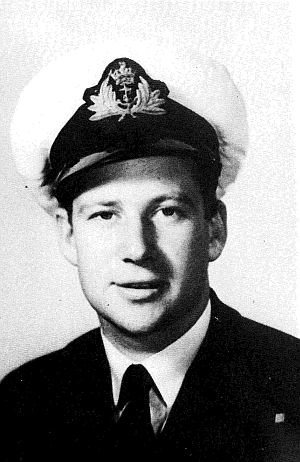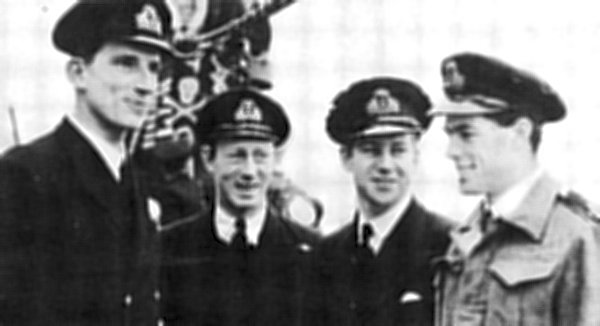

 The South African
The South African
Lt Alan (Harold) MacCoy was born on 9 September 1916 and arrived in Durban on 10 May 1937 to work for John T. Rennie and Sons. The Munich Crisis in 1938 and the partition of Czechoslovakia which followed left him in no doubt that war was inevitable, so he joined the Royal Naval Volunteer Reserve (SA Division) in Durban early in 1939. (The unit is now SAS Inkonkoni).
He was commissioned as a Temporary Probationary Acting Sub-Lieutenant by Captain J.T. Borrett, RN of HMS Amphion. On 19 September 1939 he attested for full-time service in HMS Afrikander IV at Durban where he carried out routine minesweeping and examination service duties and flew with the SAAF as an observer on sweeps over the Indian Ocean on anti-surface raider patrols.
When the Seaward Defence Force was established in January 1940, he elected to remain seconded to the Royal Navy and was drafted to HMS Afrikander in Simon's Town to attend a Gunnery Course and for general duty at Klawer Camp.
After the invasion of Norway and Denmark he returned to Durban with a Petty Officer and four ratings who were to act as armed guards aboard the Norwegian merchant vessel, Elin K, with orders to proceed to Baltimore via Freetown with a full cargo of manganese ore.
When the ship reached Freetown early in May 1940, the Elin K was declared reliable to the Allied cause and allowed to proceed independently to Baltimore. Sub-Lt MacCoy then joined the armed guard pool in the depot ship HMS Edinburgh Castle, which was aground in the harbour (reputedly on empty gin bottles!). For successfully ensuring the safe passage of the Elin K to Freetown, the Lords Commissioners of the Admiralty granted S Lt MacCoy six months seniority.
On 5 May 1940 he was appointed to HMS Pretoria Castle and served in this armed merchant cruiser engaged in routine convoy duties to and from England, Freetown and Cape Town. When the ship underwent a major refit at the end of 1940 he was appointed group officer to four trawlers which had been fitted up as anti- invasion minelayers. They carried out night patrols off Land's End, the Scilly Isles and Lizard area and operated out of Newlyn, a fishing port close to Penzance, attached to Flag Officer-in-Command, Falmouth.
Until then only RN personnel had been accepted for service in submarines but in April 1941, an Admiralty Fleet Order invited RNVR officers to apply to serve in what Mr Winston Churchill described as the most dangerous of the services. Sub-Lt MacCoy was one of the first volunteers. He was appointed to the submarine base HMS Elfin at Blyth, Northumberland in May 1941.
After passing the six·week course he was appointed to HMS Sunfish, an 'S' class submarine, refitting at Swan Hunter, Wallsend on Tyne, as 4th hand and navigator. When the refit had been completed, in September 1941, HMS Sunfish shifted to the wet basin at North Shields for diving trials to ensure that the Dockyard maties had put back all the rivets. During an air raid that night the Sunfish was badly hit for'ard by a bomb and sank. Fortunately most of the crew were ashore and the casualties, four stokers playing cards in the mess deck aft, were only slightly wounded. The First Lieutenant and Lt MacCoy were on the bridge at the time of the attack and went down the main hatch into the control room, where they put on breathing apparatus (because of the chlorine fumes) and helped the stokers out. For this gallant act Sub Lt MacCoy was commended by the Lords Commissioners of the Admiralty.

Lt Alan Maccoy, DSC.
Photo courtesy of South African Naval Museum
Lt MacCoy's next appointment was to HMS Pandora, a 'P' class submarine, refitting with HMS Parthian in Portsmouth Navy Yard in New Hampshire, America, in terms of the Anglo-American Lend-Lease agreement. He travelled to America in the relative luxury of a troopship which had been on the Pacific run to New Zealand before the war, escorted by three corvettes. In mid-Atlantic, convoy protection was provided by the US Navy despite the fact that the United States was still neutral. The USN escorts included a battleship.
By the end of 1941, HMS Pandora's refit had been completed and after sea trials in Block Island Sound off New London. Connecticut, the submarine sailed for the Mediterranean to join the 1st Submarine Flotilla in Alexandria at the end of January 1942.
After correcting some minor discrepancies in Bermuda, HMS Pandora sailed for Gibraltar where spare torpedoes and aviation fuel, stored in the midship ballast tank, were loaded for discharge in Malta.
HMS Pandora arrived at Malta on 31 March and berthed at Delimara Point. While the avgas was being discharged that night there was a heavy air raid on the fuel depot. On the following morning the Pandora shifted to Grand Harbour and berthed in Boilermakers' Creek alongside the drydock which contained the destroyer HMS Lance. Later that morning, whilst discharging torpedoes for the 10th Submarine Flotilla, a very heavy air raid developed over Grand Harbour. The main targets were the cruiser Penelope in dry dock ahead of HMS Pandora and the Lance. The Pandora received a direct hit through the engine room hatch, caught fire and sank within a few minutes. Every one inside the submarine was killed with the exception of an ERA who had a miraculous escape and crawled out unhurt.
On the bridge, which was temporarily engulfed in flames from the explosion, the First Lieutenant and Lt MacCoy were unharmed but the Navigator and Engineer Officer had disappeared. Both may have jumped overboard or been blown overboard. The Navigator's body was washed up some days later. Several of the ratings who were on the bridge jumped into the water. The First Lieutenant and Lt MacCoy went down onto the casing and pulled them out of the sea which was a hissing inferno of exploding shells and bomb splinters just before the Pandora sank.
Lt MacCoy was immediately appointed to a 'U' class submarine, P35, which was part of the 10th Submarine Flotilla operating out of Malta, commanded by Lt S.L.C. Maydon, the son of the Natal Senator after whom Maydon Wharf is named. Lt MacCoy was the torpedo officer and 4th hand. P35 was later renamed Umbra and operated very successfully out of Malta and for a brief period out of Alexandria and Haifa. Four months later Lt MacCoy was appointed First Lieutenant of another submarine. On thinking it over, however, he decided that he preferred to remain in HMS Umbra and very tentatively suggested that the appointment might be given elsewhere, which it was. The other submarine was torpedoed and sunk by an E boat off Cape Marittimo on her next patrol.
On 15 June 1942 HMS Umbra took part in a memorable action against two Italian Littorio class battleships, cruisers and destroyers which were threatening a British convoy from Gibraltar to Malta. An unexpected attack on the Italian ships by American Liberators forced the Italian squadron to scatter and denied Lt Maydon the opportunity of a relatively easy attack. The heavy cruiser Trento was severely damaged and forced to return home escorted by four destroyers.
When the squadron reformed it was out of range. HMS Umbra pursued the ships at full speed and succeeded in firing a full salvo. One torpedo hit the battleship Littorio which was severely damaged.
Lt Maydon then decided to attack the damaged cruiser Trento which he found in the middle of the morning. By then two other British submarines were closing in on her and they were present when the Umbra fired the two torpedoes which sank her within three minutes.
On the afternoon of 27 September 1942 the Umbra intercepted a convoy of two Italian ships, the Francesco Barbaro and the Unione, which were carrying urgently needed supplies for the Afrika Korps.
In December 1942 HMS Umbra assisted in 'severely handling' an enemy convoy in he Mediterranean. On 25 May 1943, Lt MacCoy was awarded he Distinguished Service Cross by HM King George VI at Buckingham Palace. The citation reads: 'For devotion to duty, coolness and cheerfulness as Torpedo Officer and Navigating Officer of His Majesty's Submarine Umbra in highly successful war patrols in the Mediterranean during the last five months of 1942.'
HMS Umbra returned to Devonport for a refit in March 1943. Lt MacCoy was then appointed First Lieutenant and Acting Commanding Officer of HMS Porpoise, refitting at Portsmouth but when it became clear that the refit would be extended he approached the Staff Officer Appointments at Northways, Swiss Cottage, the wartime Submarine HQ, to get a seagoing appointment as First Lieutenant of HMS Tantalus. He joined the submarine in Northern Ireland in June 1943, when she was on a training mission with the Atlantic Anti-Submarine Escort Groups commanded by the legendary Capt E.J. Walker, CB, DSO and three bars.
After an immensely long patrol off Spitzbergen long-range fuel tanks were fitted at Portsmouth and HMS Tantalus sailed for Trincomalee to join the 4th Submarine Flotilla early in February 1944. In another very long patrol down the Malacca Straits to Penang, the Tantalus chased and sank a Japanese supply ship of 3165 tons bound for the Andaman Isles.
Lt Maccoy was then flown to England in a Sunderland via Bombay, Bahrain, Cairo and Gibraltar to attend a two-month Submarine Commanding Officers' course (nick-named 'perisher'). He passed the course and was appointed Commanding Officer of L27 (HMS Seaborn) in Bermuda with orders to proceed with L26 to Halifax, Nova Scotia, to be fitted with a dummy Schnorkel for training exercises with the Royal Canadian Air Force. On passage both submarines encountered what Lt Maccoy described as a 'particularly unpleasant hurricane' in which they were so badly damaged that they had to be scrapped.
Lt MacCoy then returned to Bermuda to take command of HMS Unruffled attached to HMCS Somers Isles which was the Royal Canadian Navy's working up base for their frigates, corvettes and destroyers, particularly anti-submarine warfare ('ping' running). There were two other 'U' class submarines in this independent command which remained operational until the end of the war. In September 1945 they returned to the Clyde where the submarines were decommissioned and laid up at Usahally on the river Foyle. Lt MacCoy returned to South Africa in the troopship Isle de France in November 1945.
He was released from full time service and rejoined Rennies later that month. Lt MacCoy served in the SA Naval Forces Reserve at the Durban Base for about three years after the war.

Lt (later Lt Cdr) S.L.C. Maydon, DSO and bar, DSC (CO HM Submarine Umbra),
Lt Clark, RNVR, Lt AH. Maccoy, SANF, and Lt Collins, RN (First Lieutenant).
Return to Journal Index OR Society's Home page
South African Military History Society / scribe@samilitaryhistory.org